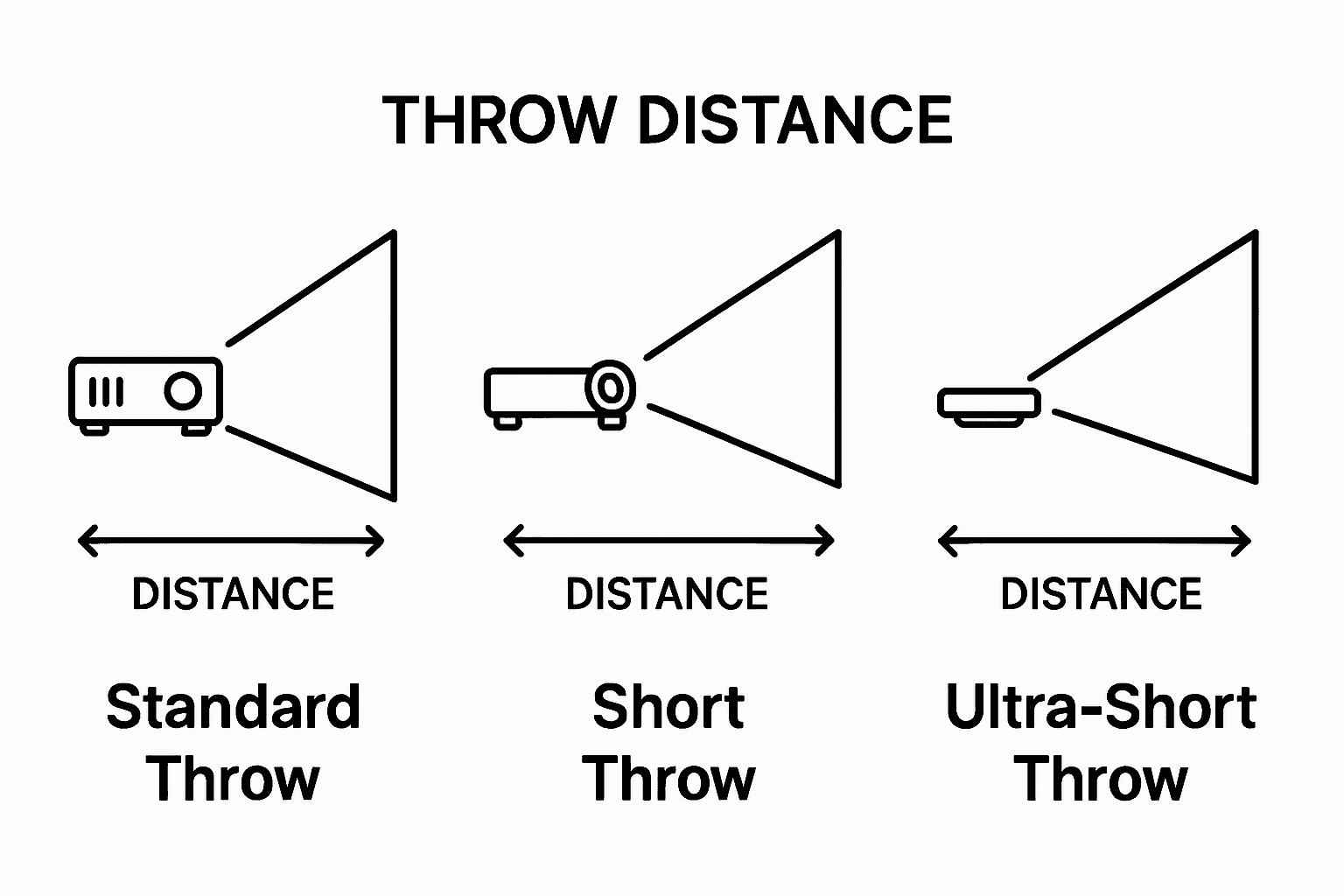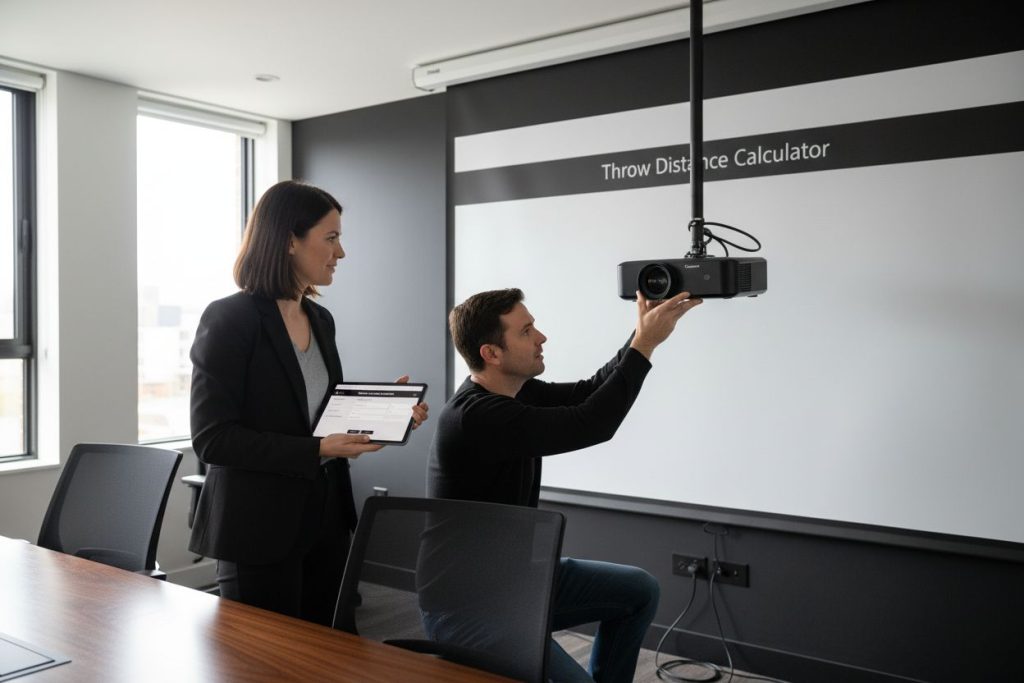Choosing the right spot for your projector is a make-or-break step for any home theater or meeting room. Most people guess and end up with blurry edges or images that spill off the screen. But here is the surprising part. A projector throw distance calculator can tell you exactly where to put your projector for crystal clear results and it only takes a few seconds. Forget guessing. Just a single calculation means zero distortion and your setup instantly looks professional. Incorrect throw distance can cause major image degradation, making precise measurement essential for sharp visuals.
Table of Contents
- What Is A Projector Throw Distance Calculator?
- Why Projector Throw Distance Is Important
- How Projector Throw Distance Works
- Key Concepts In Projector Throw Distances
- Real-World Applications Of Throw Distance Calculation
Quick Summary
| Takeaway | Explanation |
|---|---|
| Accurate placement enhances image quality. | Precise projector positioning prevents issues like blurred edges and poor clarity, vital for professional settings. |
| Input specifications for optimal results. | Using projector model and screen size data yields tailored distance recommendations for setup. |
| Different projectors suit various distances. | Standard, short-throw, and ultra-short-throw projectors offer flexibility for diverse room configurations. |
| Calculated distances maximize space utilization. | Knowing the throw distance helps achieve desired screen sizes while optimizing room arrangement. |
| Throw distance impacts visual experiences significantly. | Understanding throw distance enhances presentations for educational, professional, and entertainment purposes. |
What is a Projector Throw Distance Calculator?
A projector throw distance calculator is a specialized digital tool designed to help users determine the precise projection distance required to achieve a specific screen size for their projector setup. Unlike guesswork or manual measurements, this calculator provides accurate mathematical calculations that take into account the unique optical characteristics of different projector models.
The Core Purpose of Throw Distance Calculation
The fundamental goal of a projector throw distance calculator is to solve a critical spatial challenge: determining how far a projector needs to be positioned from a screen or wall to create an optimal image size. Every projector has unique lens specifications that influence its throw ratio, which represents the relationship between the projector's distance from the screen and the resulting image width.
Key Aspects of Throw Distance Calculation:
- Determines precise projector placement for desired screen dimensions
- Accounts for specific projector model lens characteristics
- Prevents image distortion and quality degradation
- Helps users maximize available space and projection quality
How Throw Distance Calculators Work
Throw distance calculators utilize complex optical formulas to translate technical specifications into practical positioning recommendations. By inputting specific parameters such as projector model, desired screen size, and available room dimensions, users receive precise recommended placement distances.
For instance, ProjectorDisplay.com offers comprehensive projection guidance to help users understand these intricate calculations. The calculator typically requires users to input:
- Projector model specifications
- Desired screen width or diagonal measurement
- Room or mounting location constraints
Understanding throw distance is crucial for creating immersive visual experiences, whether in home theaters, classrooms, or professional presentation environments. By leveraging these digital tools, users can optimize their projection setup with unprecedented accuracy and confidence.
Why Projector Throw Distance is Important
Projector throw distance represents a critical technical parameter that significantly impacts the overall quality and effectiveness of visual presentations across multiple environments. Understanding its importance goes beyond mere technical specifications and directly influences the user experience, projection quality, and spatial efficiency of display setups.
Image Quality and Projection Precision
The relationship between projector placement and screen size determines fundamental visual characteristics. Incorrect throw distance can lead to substantial image degradation, resulting in blurred edges, reduced clarity, and compromised visual performance. Professional settings like conference rooms, educational institutions, and home theaters demand precise projection to maintain high-quality visual communication.
Critical Factors Affecting Image Quality:
- Optimal lens-to-screen positioning
- Maintaining consistent image sharpness
- Preventing geometric distortion
- Ensuring uniform brightness distribution
Spatial Optimization and Flexibility
Throw distance calculations enable users to maximize available space while achieving desired screen dimensions. Different projector types such as standard, short-throw, and ultra-short-throw models offer varying placement flexibilities. Explore our comprehensive home theater projector guide to understand how throw distance impacts room layout and projection strategies.
Space Utilization Considerations:
- Determining optimal projector mounting locations
- Adapting to room size and architectural constraints
- Minimizing obstruction and shadow interference
- Balancing aesthetic and functional requirements
Professional audiovisual integrators and home entertainment enthusiasts recognize throw distance as a fundamental technical consideration.
 By understanding and precisely calculating throw distance, users can transform ordinary spaces into immersive visual environments with exceptional clarity and performance.
By understanding and precisely calculating throw distance, users can transform ordinary spaces into immersive visual environments with exceptional clarity and performance.
How Projector Throw Distance Works
Projector throw distance operates through a sophisticated mathematical relationship between lens optics, projection angle, and screen dimensions. Understanding this mechanism requires exploring the intricate interactions between projector hardware and spatial positioning.
The Optical Mechanics of Projection
At its core, throw distance is defined by the throw ratio, a critical specification that describes the width of the projected image relative to the projector's distance from the screen. This ratio represents a precise calculation of how lens design influences image projection. A standard throw ratio might be 2:1, meaning for every two feet of distance, the projector creates one foot of image width.
Key Components of Throw Ratio:
- Lens focal length
- Projection angle
- Optical element configurations
- Mechanical lens design
Throw Distance Categories
Projectors are categorized into distinct throw distance classifications, each suited for different spatial environments. Learn more about our advanced projection technologies that accommodate various installation requirements.
Projection Distance Classifications:
- Standard throw (traditional long-distance projection)
- Short throw (minimal distance required)
- Ultra-short throw (extremely close positioning)
- Long throw (extensive projection distances)
Each classification represents a unique engineering approach to managing optical performance, enabling projection solutions that can adapt to diverse room configurations and user needs.
The following table summarizes the main categories of projector throw distances, outlining their typical use and placement characteristics to help you identify which is best for your space.
| Throw Distance Category | Description | Typical Placement Environment |
|---|---|---|
| Standard Throw | Requires moderate to long distance from screen | Large rooms, traditional home theaters |
| Short Throw | Projects large images from short distance | Small to medium rooms, classrooms |
| Ultra-Short Throw | Can be placed very close to the screen/wall | Tight spaces, offices, interactive displays |
| Long Throw | Requires substantial distance for projection | Large halls, auditoriums, event venues |
 Professional audiovisual designers carefully select projectors based on these intricate throw distance characteristics to ensure optimal visual performance across different environments.
Professional audiovisual designers carefully select projectors based on these intricate throw distance characteristics to ensure optimal visual performance across different environments.
Key Concepts in Projector Throw Distances
Projector throw distance involves a complex interplay of optical principles, technological specifications, and spatial considerations. Understanding these fundamental concepts helps users make informed decisions about projection setups and optimize visual performance across various environments.
Fundamental Optical Principles
Throw ratio represents the mathematical relationship between projector placement and image size, serving as the cornerstone of projection technology. This critical specification determines how images are generated and scaled based on physical positioning. Projection geometry involves precise calculations of lens focal length, projection angle, and image scaling mechanisms.
Essential Optical Parameters:
- Lens focal length and optical design
- Light path and projection angles
- Image scaling algorithms
- Geometric transformation capabilities
Technical Performance Considerations
Projection performance extends beyond simple distance measurements. Image quality, brightness uniformity, and geometric accuracy depend on sophisticated interactions between projector hardware and environmental conditions. Explore advanced projection connectivity options that enhance projection flexibility and performance.
Critical Performance Metrics:
- Lumens output and light distribution
- Color accuracy and reproduction
- Resolution maintenance across different distances
- Keystoning and geometric correction capabilities
Professional audiovisual experts recognize that throw distance is not merely a technical specification but a comprehensive system of optical engineering.
This table organizes key optical and technical factors that affect projector throw distance and image quality, providing a clear reference to understand their individual impact on projection setup decisions.
| Aspect | Explanation |
|---|---|
| Throw Ratio | Ratio of projector distance to image width, defining how far to place unit |
| Lens Focal Length | Determines image size at a specific distance |
| Projection Angle | Affects coverage area and required placement |
| Brightness (Lumens Output) | Impacts clarity and uniformity across different throw distances |
| Keystoning/Correction | Adjusts image shape to address geometric distortion |
Real-World Applications of Throw Distance Calculation
Throw distance calculation extends far beyond traditional projection environments, finding critical applications across diverse professional and consumer sectors. Understanding how precise optical positioning impacts visual technologies reveals the fundamental importance of accurate distance measurements.
Professional and Commercial Environments
Projection technologies play pivotal roles in conference rooms, educational institutions, and corporate training facilities. Precise throw distance calculations enable seamless visual presentations, ensuring maximum screen coverage without compromising image quality. Strategic placement determines the effectiveness of visual communication, making throw distance calculations essential for professional audiovisual integrators.
Key Professional Application Areas:
- Corporate boardroom presentations
- Large-scale educational lecture halls
- Museum and exhibition display systems
- Professional training and simulation environments
Advanced Technical Applications
Beyond standard projection scenarios, throw distance calculations support sophisticated technological implementations. Explore cutting-edge projection technologies that demonstrate the versatility of precise optical positioning.
Innovative Technical Deployment Scenarios:
- Automotive head-up display systems
- Medical imaging and surgical visualization
- Architectural and design visualization
- Immersive virtual reality environments
Professional engineers recognize that throw distance calculations represent more than mathematical computations. They are sophisticated problem-solving tools that bridge complex optical principles with practical technological implementations, enabling transformative visual experiences across multiple domains.
Make Your Projector Setup Simple and Perfect
Struggling to find the right spot for your projector so your images look sharp and professional? You are not alone. Many people worry about image quality, room size, and choosing the right equipment to match their throw distance needs. The article explains how a projector throw distance calculator takes away the guesswork by helping you select the proper placement for the best visual experience. But understanding the science is just the first step – having the right tools and accessories is what makes the theory work in your actual space. To truly put your new knowledge into action, you need projector screens that pair perfectly with your throw distance and projector model. Visit our Projector Screen archives to discover the right options for your room and taste.

Now is the best time to build a flawless projection setup that fits your needs, whether it is for entertainment or a professional setting. Explore the full selection of high-quality projectors, screens, and accessories at ProjectorDisplay.com and experience the difference. Take the guessing out of your projection plans and move one step closer to the perfect viewing experience.
Frequently Asked Questions
What is a projector throw distance calculator?
A projector throw distance calculator is a digital tool that helps users determine the distance required to achieve a specific screen size for their projector setup, ensuring accurate placement for optimal image quality.
How does a projector throw distance calculator work?
The calculator uses complex optical formulas, requiring users to input parameters like projector model, desired screen size, and room dimensions to provide precise recommendations for projector placement.
Why is understanding throw distance important for projector setups?
Understanding throw distance is crucial because incorrect placement can lead to image degradation, such as blurred edges and reduced clarity. Precise calculations ensure optimal image quality and effective use of space.
What types of projectors are there based on throw distance?
Projectors can be categorized into standard throw, short throw, ultra-short throw, and long throw, each designed for different spatial environments and mounting requirements.
Recommended
- Projector Screen Size Guide 2025: Perfect Fit for Malaysian Needs – Projector Display
- Mirror Phone to Projector: Easy Ways for Malaysians 2025 – Projector Display
- Epson EB-L630SU 3LCD WUXGA 6,000 Lumens Short-throw Business Laser Projector | Built-In Wireless – Projector Display
- Epson EB-L770U WUXGA 7000 Lumens 3LCD Laser Projector With 4K Enhancement – Projector Display

